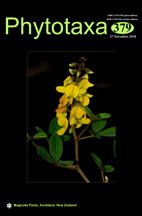Abstract
The genus Haumania (Marantaceae) consists of three described species of perennial climbers endemic to the tropical lowland rainforest in Central Africa. To unravel their phylogenetic relationship to each other, we used variation among DNA sequences of two nuclear ribosomal (nr) and four plastid (p) markers in five to seven accessions per species sampled across their respective distribution range. Maximum parsimony and Bayesian analyses were applied. All datasets and analyses corroborated the monophyly of the genus. Within the genus, individuals of the species H. danckelmaniana and H. leonardiana were each monophyletic. Individuals of H. liebrechtsiana, however, were paraphyletic. They clustered into two distinct geographic clades (Gabon and Democratic Republic of Congo), with the Gabonese clade being most closely related to the individuals of H. danckelmaniana. The latter might be due to introgression in areas of distributional overlap between these two species, as shown in earlier phylogeographic studies. A recent hybridisation event between H. danckelmaniana and H. liebrechtsiana is documented here in a single individual by incongruence in the nr and p dataset. Overall, the study provides support for H. leonardiana being sister to all other species of this genus. To confirm the absence of hybridisation in H. leonardiana further sampling is proposed in the respective areas of distributional overlap with its sister species.

